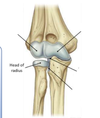MSK HARC booklet Flashcards
(101 cards)
WHat is another name for shoulder joint?
glenohumeral joint

. The articular surfaces are covered by ______ ______
hyaline cartilage
The stability of the shoulder joint is dependent on: (3)
- Glenoid labrum – a fibrocartilaginous rim that deepens the glenoid cavity
- Rotator cuff muscles
- Ligaments


You should appreciate that the tendons of rotator muscles blend with the glenohumeral joint capsule to form a_________ _______that surrounds the anterior, posterior, and superior aspects of the joint.
a musculotendinous colla




determine the structures that make up the boundaries of the axilla.
Medial:
Lateral:
Anterior:
Posterior:
Medial: Upper ribs and intercostal spaces covered by the superior part of serratus anterior
Lateral: Intertubercular groove of the humerus
Anterior: Pectoralis major overlying pectoralis minor and subclavius
Posterior: Subscapularis above; teres major and latissimus dorsi below
Name the structures that can be found within the axilla.
Axillary artery (and its tributaries); axillary vein (and its tributaries); cords of the brachial plexus; proximal parts of the coracobrachialis and biceps brachii; lymph nodes; axillary process of the breast.


What are functions of the ligament before?
- Glenohumeral ligament: .
- Coracohumeral ligament:
- Transverse humeral ligament:
- Coracoacromial ligament:
- Glenohumeral ligament: three weak bands of fibrous tissue that run from the glenoid cavity to the lesser tubercle of the humerus extending inferiorly to the anatomical neck.
- Coracohumeral ligament: stretches between the base of the coracoid process of the scapula to the greater tubercle of the humerus.
- Transverse humeral ligament: bridges the gap between the two tubercles of the humerus. Holds the long head of the biceps in the intertubercular groove.
- Coracoacromial ligament: an accessory ligament that extends between the coracoid process and acromion of the scapula


The shoulder joint is the most commonly dislocated large joint. In which direction does it normally dislocate?
Anterior (95%). Most often due to excessive extension and lateral rotation of the arm, or a blow to a fully abducted arm.
Which nerve is most at risk of damage due to an inferior dislocation at the shoulder joint?
The axillary nerve runs close to the joint and surgical neck of the humerus. It can be damaged due to direct compression of the nerve inferiorly as it leaves the axilla by passing through the quadrangular space. This would result in paralysis of the deltoid muscle and loss of sensation over the upper lateral side of the arm (regimental badge area). Injury to the axillary nerve during shoulder dislocation is as high as 40%.
Wear of the rotator cuff is usually related to what?
age
Inflammation and tearing of the rotator cuff is associated with _______ ______ ____
Inflammation and tearing of the rotator cuff is associated with excessive repetitive use
Which muscle of the rotator cuff is most frequently injured?
The supraspinatus. It passes beneath the acromion and acromioclavicular ligament and is therefore most exposed to friction against them during abduction of the shoulder.
Under normal circumstances the amount of friction between the supraspinatus tendon and the acromion is reduced to a minimum by the large s_________ _____, which extends laterally beneath the deltoid.
Under normal circumstances the amount of friction between the supraspinatus tendon and the acromion is reduced to a minimum by the large subacromial bursa, which extends laterally beneath the deltoid.
Degenerative changes in the bursa are followed by degenerative changes in the underlying supraspinatus tendon
What is this called?
subacromial bursitis, supraspinatus tendinitis, or pericapsulitis
What is ‘painful arc syndrome’?
It is the presence of a spasm of pain in the middle range of abduction, which is characteristic of supraspinatus tendinitis. When the glenohumeral joint is adducted, initially no pain is felt, but as the arm is abducted to 50-130 degrees pain occurs as the diseased area impinges on the acromion.


Which of the articulations are primarily involved with the hinge-like flexion and extension of the forearm on the arm?
The articulation between the trochlea of the humerus and the trochlea notch of the ulna, and the articulation between the capitulum of the humerus and the head of the radius.
Which of the articulations is involved with pronation and supination of the forearm?
The articulation between the head of the radius and the radial notch of the ulna.

























